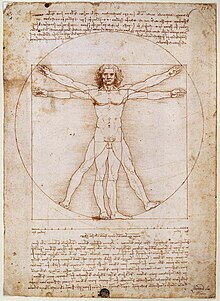Estimation of stature
[3][4] The principle behind this forensic anthropology technique is the fact that for a given combination of age, race, and gender there measurements of different body parts which have a relationship to the stature.
Vitruvius, who lived in the first century BC had put forth the proportions of human body in Book III, Chapter 1.. 3.
He excluded those aged above 60 years from his sample and derived tables of average stature corresponding to given long bone lengths.
[6] Breitinger (1937) measured the distance between certain anatomical prominence in a sample of 2400 German males of whom 1400 were participants in an athletic meet in Munich in 1923.
[10] The regression equations to calculate stature in centimeters for male servicemen belonging to different races derived by Trotter and Gleser.
[8] The regression equations derived by Dupertuis and Hadden for Whites and Blacks to estimate the stature in centimeters from individual long bones and different combinations are given below.
[7] Various studies have been undertaken into methods to device the estimation of stature from foot prints, measurement of severed body parts etc.

